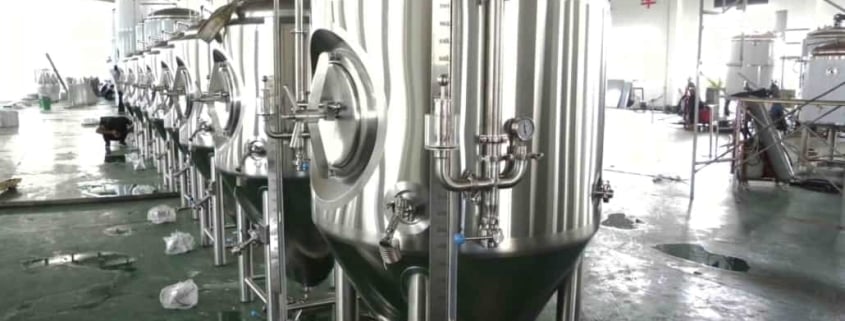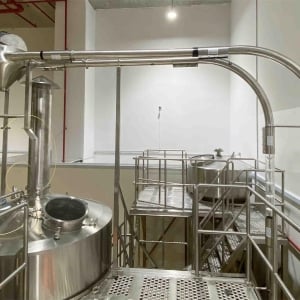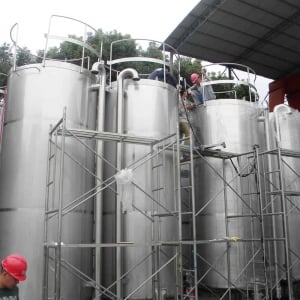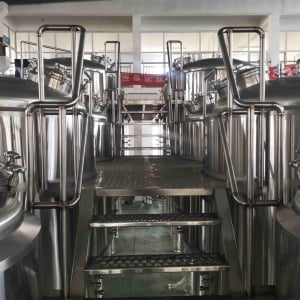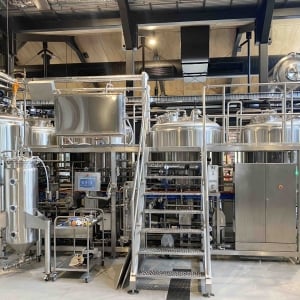Commercial Beer Equipment
commercial beer equipment requires specialized equipment to brew and ferment beer on a large scale. Key equipment includes:
Brew House – Mixes hot water with malted grains to extract sugars and produce wort. Includes mash tuns, lauter tuns, brew kettles.
Fermentation Tanks – Stainless steel vessels where yeast ferments wort into beer over days or weeks. Control temperature and environment.
Brite Tanks – Beer storage tanks that allow sediment to settle and finalize carbonation before packaging.
Filtration Systems – Remove haze and particles from beer after fermentation. Plate filters or centrifuge systems.
Cleaning/Sanitation – CIP systems use heat, pressure, chemicals to clean interior surfaces. Reduce contamination between batches.
Packaging – Fill beer into bottles, cans, kegs for distribution. Requires fillers, crowners, palletizers matched to package type.
Cooling – Precise temp control needed in brewing. Glycol chillers and heat exchangers used to regulate system temperature.
Process Control – Instruments like flow meters, density gauges used to monitor variables, automate valves/pumps.
Quality Control – Lab equipment to test beer – alcohol, color, bitterness, microbes, sugars. Ensure consistency and safety.
Commercial Beer Equipment Types
| Equipment | Typical Sizes | Key Parameters |
|---|---|---|
| Brewhouse | 3-100 barrel batches | Automation level, material (stainless, copper) |
| Fermenters | 30-300 barrel capacity | Cooling method, conical or cylindroconical |
| Brite Tanks | Equivalent to ferment size | ASME rated, mixing options |
| Bottle Fillers | 100-2000 bph | 12/16/22 oz bottle capabilities |
| Can Fillers | 100-2000 cph | Aluminum vs steel cans |
| Keg Fillers | 1/6 barrel, 1/2 barrel | Single or multi-fill head |
| CIP Systems | Matched to vessel sizes | Tank mixproof valves, self-cleaning |
| Chillers | 50-500 ton capacity | Glycol/ammonia, degree of redundancy |
| Automation | Touchscreen HMI, PLC | Data collection, advanced algorithms |
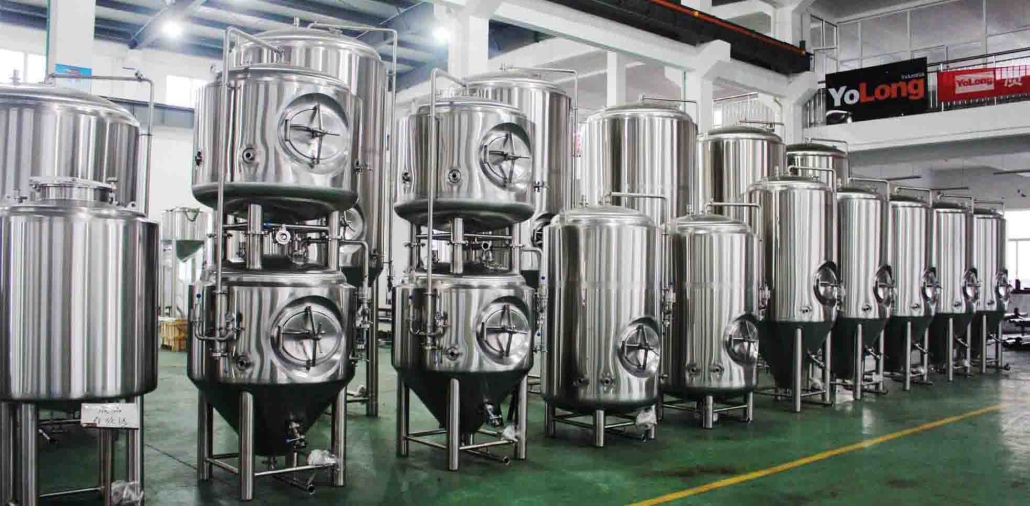
Brewing Process Equipment
Commercial beer production begins with quality ingredients – water, malt, hops and yeast. The basic process uses hot water and malted grains to produce a sugar-rich wort, which gets boiled with hops for bitterness and flavor. The hopped wort ferments for days to weeks, allowing the yeast to convert sugars into alcohol and CO2. The green beer is clarified, filtered, and carbonated before packaging into kegs, bottles or cans.
Milling – Crack malt kernel to access starches needed for mash. Require roller or hammer mills.
Mashing – Mix milled malt with hot water, activate malt enzymes to convert starch into fermentable sugars. Performed in mash tun vessel with mixer.
Lautering – Separate sweet wort from grains. Filter bed in lauter tun retains solids as liquid gets pumped out.
Boiling – Adds hops for bitterness, flavor, aroma. Evaporates DMS precursor. Sanitization benefit. Brew kettle is main vessel.
Whirlpool – Spinning action at end of boil separates trub solids from wort. Settles in cone at center of the kettle.
Cooling – Rapidly chill boiled wort to fermentation temp. Plate heat exchangers or glycol jackets.
Aeration – Dissolve oxygen into cooled wort for healthy fermentation. Use air injection or oxygenation stone.
Fermentation – Yeast converts wort sugars into CO2, ethanol over days/weeks. Temperature controlled stainless steel vessels.
Maturation – Additional aging time to smooth flavor. Lagering done at cold temps for extended period.
Carbonation – Inject CO2 or add priming sugar to naturally carbonate. Brite tank mixing ensures uniformity.
Filtration – Remove haze particles with depth filters or centrifuge. Produce bright, stable beer.
Packaging – Fill bright beer into packages without oxygen pickup. Maintain sterile lines.
Commercial Beer Equipment Sizing
Proper equipment sizing is critical when designing a commercial brewery. Balance production goals with space constraints and budget. Consider peaks in production schedule when sizing.
| Equipment | Capacity Range | Typical Space Needs | Key Considerations |
|---|---|---|---|
| Brewhouse | 3-20 barrel systems common for craft breweries aiming for 5000-40000 BBL/year production. Up to 100 bbl systems for large regional brewers doing 100000+ BBL annually | Height clearance needed for grain handling into mash tun. 10-20 ft ceiling, 800-2000 sqft footprint | Match brewhouse batch size to fermentation tank volume. Scale up incrementally. |
| Fermenters | Craft breweries may start with (4-6) 30 or 60 barrel tanks. Regional breweries use 100-500 barrel scale. | Ceiling height 18 ft+. Up to 2000 sqft for tank farm. glycol chiller needs mezzanine space. | Maximize fermentation capacity for production goals. Size Bright tanks equivalent to fermenters. |
| Brite Tanks | Equivalent to ferment sizes above | Grouped together with fermenters, may be taller tanks. | Determine packaging line speeds to size appropriately. Include headspace. |
| Packaging Lines | Craft bottle/can lines run at 100-300 packages/min. Large packaging lines approach 2000 packages/min throughput. | Requires long straight conveyor runs. Height for palletizing. 5000+ sqft. | Choose inline vs rotary fillers. Scale up number of filling heads. |
| CIP Systems | Matched to sized of vessels above. Reuse cleaning solution. | Room for storage tanks, pumps near the brewhouse. | Automated multi-tank CIP offers time savings. |
| Chillers | Craft 50 ton glycol chiller common. Larger breweries 200-500 ton capacity | Place glycol chiller externally or on mezzanine if height allows | Design redundancy with multiple chillers for uptime. |
Layout and Flow
Good equipment layout and material flow are essential in brewery design. The major systems should be arranged linearly to follow the natural brewing process:
Raw Materials > Milling > Brewhouse > Fermentation > Filtration > Packaging > Warehousing
- Optimizing travel distance from grain handling to milling saves on labor costs
- Pump connections should link the mash tun, lauter tun, brew kettle, and whirlpool seamlessly
- Easy transfer from fermenters down to filter and bright tanks reduces oxygen uptake
- Adjacent packaging room to limit travel of finished beer
Gravity flow should be utilized wherever possible – pumping adds risk of DO pickup and contamination. Consider equipment height differentials and slope floors appropriately so liquid can drain through each system.
Leave room for expansion. Breweries often underestimate production growth which necessitates added fermentation tanks and packaging capacity down the road.
Customization
While turnkey systems are available, often a customized combination of equipment is preferred to perfectly match process objectives. Component choices include:
Mash Tun
- Grant style mash tun with external rakes
- Automated internal mixer for uniformity
Lauter Tun
- Traditional rake and trough
- Revolving system for spent grains
Brew Kettle
- Tilted kettle with top-mount calandria
- External wort boiler for precise control
Fermentation
- Uncoated or stainless steel coated tanks
- Jacketed cooling vs glycol or brine recirculation
Filters
- Plate and frame design – easier maintenance
- High-speed centrifuges – faster but consumables cost
Filler Types
- Volumetric piston fillers – reliable for glass
- Rotary style with crowner – speed for cans
Customization allows brewers to specify exotic materials like copper kettles or optimize tank geometry and valves. An open plan brewhouse offers flexibility for future enhancements.
Suppliers and Cost Considerations
| Equipment | Key Manufacturers | Cost Range |
|---|---|---|
| Brewhouse | AAA, JVNW, SS Tanks & Kettles, Brewmation | $100,000 – $500,000 |
| Fermentation Tanks | AAA, JVNW, SS Brewtech, Unitank | $5000 – $15000 per tank |
| Filtration | Meura, Alfa Laval, GEA | $50,000 to $250,000+ |
| Packaging Lines |
Choosing a Supplier
Selecting qualified vendors is key when purchasing commercial brewing equipment. Below are important criteria when evaluating suppliers:
Experience
- Years of demonstrated success outfitting breweries of your scale
- Deep expertise with available options and customization
Quality & Testing
- High quality stainless steel materials and precision fabrication
- Pressure rated vessels certified to ASME standards
- Multi-point inspection and factory testing
Project Management
- Handles full project scope including installation support
- Engineering support for optimized floor plan and flow
- Oversees subcontractors – electrical, contractors
Customer Service
- Responsive to requests for quotes and questions
- Can facilitate site visits to existing customer brewhouses
- Resolves warranty issues professionally
Overall Value
- Competitive pricing paired with quality equipment that lasts
- Great after-sales service support
When vetting suppliers, request 3+ brewery references and call them directly to learn about their experience. This first-hand feedback is invaluable during decision making process.
Pros, Cons and Limitations
Each type of commercial brewing equipment has inherent advantages and disadvantages that influence selection:
| Equipment | Pros | Cons | Limitations |
|---|---|---|---|
| Open Fermenters | Lower cost, easier cleaning | Risk of contamination, less temperature control | Limited to certain beer styles best suited to open fermentation |
| Conical Fermenters | Efficient single vessel design, better sanitation | Added cost, taller height | Maximum practical size around 600-800 barrels |
| Centrifuge | Fast filtration rate, dry waste | High consumables cost, frequent maintenance | Sheer sensitivity limits lifespan for highly hopped styles |
| Bottle Fillers | Wide range of bottle formats, gentle fill | Slowest packaging rate, size changeover downtime | Older lines may lack modern safety features |
| Can Fillers | High speed packaging, lower DO pickup | Line changeovers require purges, expensive tooling | Limited to standard can dimensions |
When evaluating options, consider both tangible as well as “soft” pros and cons for fit with brewmaster preferences and company culture around flexibility, automation, innovation and more.
FAQ
What is the lead time for commercial brewing equipment?
Lead times range from 10-16 weeks for fermenters and brite tanks to 20-30+ weeks for brewhouse vessels and packaging lines requiring customization. Electrical/installation work can also lengthen timelines.
What design options are best to simplify cleaning?
Equipment choices to reduce cleaning workload – sprayball CIP systems, cone bottom tanks, tri-clover connections, external jacket cooling to minimize contamination areas.
How much does a 10 barrel brewhouse cost?
A complete 10 barrel craft brewhouse costs $250,000 to $400,000+ depending on features. Kettle upgrades to steam, automated controls or exotic metals increase costs substantially.
What are ways to reduce capital equipment costs for new breweries?
Buy used equipment; Seek brewhouse manufacturer discounts for multiple fermenter purchases; Share packaging lines with other local breweries; Lease instead of purchase packaging equipment.
How many barrels can a 3-vessel 50 ton glycol chiller support annually?
A properly sized 50 ton chiller can support 1500-4000 barrels annual production depending on ratio of fermentation to brite tanks, packaging line speeds and production schedule. Redundancy improves capacity.
What are design best practices to make cleaning and maintenance easy?
Ensure sufficient space between tanks/vessels for access; Use open racking for accessible pipe runs; Specify tri-clamp connections; Include grated trench drains throughout brew areas; Design self-draining tank geometry.

